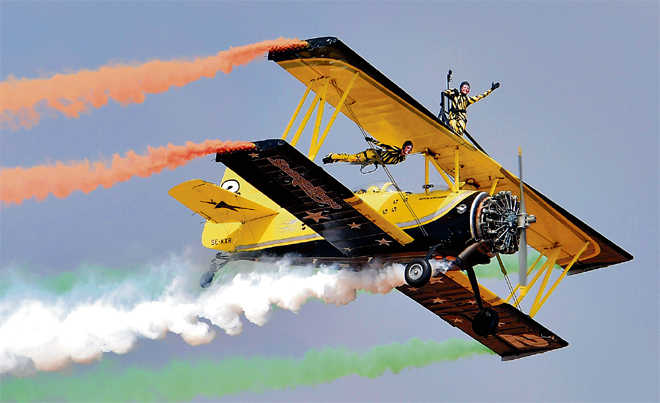
Bengaluru’s Gain: Aero show depicts defence resources not evenly distributed.
Bhartendu Kumar Singh
Indian Defence Accounts Service
Bengaluru is the best address on India's defence infrastructure map. Apart from the Karnataka and Kerala sub-area of the Army and Training Command of the Indian Air Force, Hindustan Aeronautics Limited (HAL) along with other defence PSUs have bases here. So do several laboratories of the Defence Research and Development Organisation (DRDO).
The Department of Space is based here along with the offices of several departments working closely with the Ministry of Defence. The first defence industrial production corridor (DIPC) is coming on the Bengluru-Chennai sector. While the ever-lucky Bengaluru would again host the 2019 Aero India show, the protests and bargaining by a few states expose issues about defence, development and public policy choices that need debate.
Bengaluru exemplifies how politics of development plays upon regional sentiments where competition for resources overrides other considerations. The city has benefited from the Aero India shows, held at the Yelahanka Air Force Station since 1996. The aerospace and aviation industries have matured along with ancillary sectors in defence manufacturing, best reflected in the Light Combat Aircraft project. The Aero India polemics, nevertheless, only reflects perpetuation of development for some regions and underdevelopment for others and the resultant resistance to reform proposals.
Defence resources are not evenly distributed in the country. The northern, western and southern states have managed a major proportion in terms of employability, operational presence and defence industry infrastructure. The eastern, central and north-eastern states remain poor cousins. In UP, there is almost nothing in terms of defence infrastructure east of Lucknow, except one small Air Force base in Gorakhpur, a project-stage Ordnance Factory in Sultanpur and cantonment areas in Varanasi and Faizabad. In Bihar, there is zero defence infrastructure north of the Ganga, except one tiny Air Force base in Darbhanga. Some installations are moving out, such as the recent migration of the Army Service Corps offices from Gaya to Bengaluru. The once majestic seven-storeyed building of the Controller of Defence Accounts, Patna, looks deserted due to migration of defence business to Guwahati, Siliguri, Kolkata etc and reduced number of staff. The 17-year-old Nalanda Ordnance Factory is yet to go fully critical. Chhattisgarh is equally deprived. Several factors explain these anomalies:
1 During the British period, the ordnance factories were set up in safe hinterlands. Regimental centres and cantonments were set up mostly in hill stations. Areas like Punjab, Haryana, Himachal Pradesh and Uttarakhand became the hub of military recruitments under the so-called martial race theories.
2 In the post-Independence period, defence was the Planning Commission's mandate and budgeted as non-Plan expenditure. Major capital projects in defence remained out of the commission's purview and were determined by operational factors and locational convenience. Pune, Hyderabad and Bengaluru emerged as the preferred places.
3 Defence set-ups in isolated locations, expected to act as 'engines of growth', like Medak (Telangana), Bolangir (Odisha) and Jabalpur (MP), could not do so due to locational disadvantages and supply-chain issues. Some of these factories were not based on established cannons of industrial location theories and have been struggling since the start.
Rationalisation of future defence infrastructure, like the Defence Expo, can facilitate in pushing defence and development towards backward areas of the country and provide them with incentives in industrialisation. Findings from development indicators point towards a stark regional inequality. For example, according to the fourth round of the National Family Health Survey (NFHS-4), released in January 2018, Bihar is the poorest state. It has 43 per cent incidence of multidimensional poverty and has more than 50 per cent of its households in the bottom wealth quintile. According to the World Bank (February 2018), Low Income States (LIS), ie Bihar, Chhattisgarh, Jharkhand, MP, Odisha, Rajasthan and UP, continue to lag behind the rest of the country. Poverty reduction in these states was also not as responsive as economic growth in the rest of the country.
The historical dichotomy in economic vis-a-vis political experiences of federalism implied that while the latter facilitated equality for states on population basis, the former perpetuated regional inequality masquerading under technocratic hubris. Defence is a classic public good where distributive justice has not been in sync with the regional development spirit and has been laced with unintended biases. Also, defence and development have been treated as watertight departments in our public policy and academic discourse. The developmental potential of the defence sector has not been properly debated. Defence industrialisation does need planning and hand-holding by the government through affirmative policy support since the government is the sole buyer of defence goods.
We, therefore, need public policy instruments towards defence industrialisation in backward areas for infrastructure upgradation, employment generation and meeting our weapons' requirement in a cost-effective manner. The Make-in-India initiative, supplemented by the setting up of two dedicated DIPCs, could be the game-changers. The Technology Perspective and Capability Roadmap (February 2018) can guide futuristic industries in DIPCs. However, the draft defence production policy (April 2018) is silent on linkage of defence and development in areas outside the two DIPCs.
Modern defence industries have often been called 'arsenals of democracy'. However, in the Indian context, they need democratic distribution. This necessitates public policy debates on the complementary nature of defence and development and their potential in plugging regional inequalities. Probably, therein lies a way out for dealing with competitive politics on controversies like the Aero India Show.
Views are personal



























